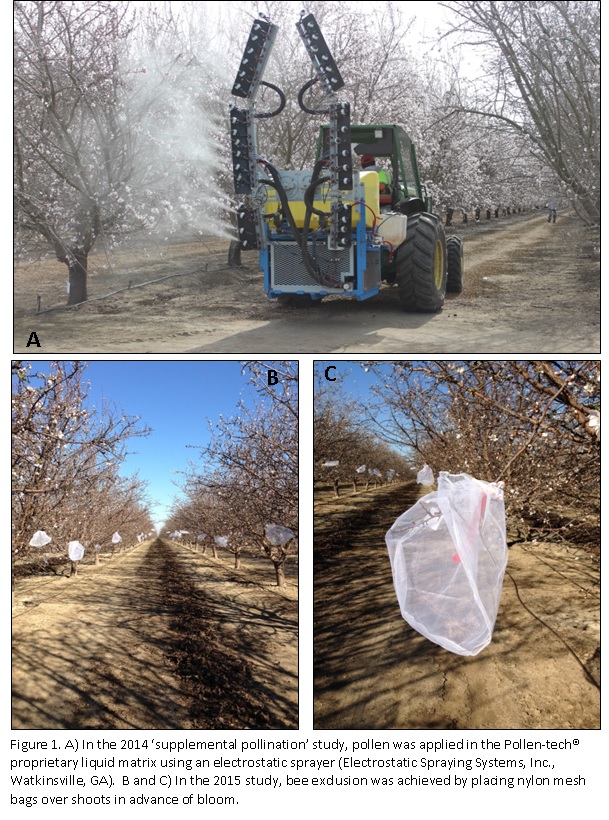By Cecilia Parsons
Every year in early February, University of California Cooperative Extension (UCCE) farm advisor Elizabeth Fichtner said, she gets calls from anxious almond growers about using supplemental pollination in their orchards to ensure profitable yields.
Challenging Weather
Growers have concerns about almond pollination, she said, when the extended weather forecasts call for cool, cloudy and rainy days. Their bee supplier may not be able to deliver adequate numbers of hives or hive strength may be an issue when there are fewer hours that bees will fly.
This year was one of those challenging times of cool, wet weather that is not conducive to bee activity when flowers are blooming. The past winter may have been one of those times to consider supplemental pollination, but at Almond Day in June, Ficthner explained the mechanics of pollination as a process rather than a one-time event.
Pollination
Almond pollination is unique among prunus species in that the ovule is not mature at bloom. Pollination and pollen tube development stimulate embryo sac development and embryo sac maturation occurs about one week after bloom. When brown stigmas are present, the flower is no longer receptive to pollen.
In addition, achieving a higher nut set may not be a good enough reason to try supplemental pollination as there is a limit to the amount of fruit a tree can support.
Fichtner said there are not enough carbohydrates in a tree to support 100 percent pollination of flowers. In commercial orchards with adequate bee pollination, typical nut set is about 30 percent of the flowers.
Considerations for Mechanical Pollen Application
There are two approaches to mechanical application of pollen in almonds. Pollen collected from compatible varieties can be blown into the trees with a blower attachment behind a tractor or flown on with fixed wing aircraft. Pollen dispensers, placed in hives can also be used to coat bees with pollen that they distribute. This has not been proven effective as bees fly up and down rows not across.
Quality of pollen, timing of application of pollen and orchard design are major considerations for supplemental pollination. Pollen is only viable for a limited time.
Research has shown there is no benefit to mechanical supplementation on nut yield when Nonpareil rows are spanned on ether side by pollinizer trees.
Bee activity is still needed to distribute supplemental pollen blown on trees. As a one-time event, this method only has the potential to pollinate the fraction of flowers receptive at the time of the application. It is also difficult to determine if bee colonies did a good job of pollination until it is almost too late for mechanical supplementation.
Pollen Inserts
Pollen inserts have been found to work in some situations, but not in newer plantings. The Journal of Apicultural Research noted that pollen dispensers did not increase fruit set percent or yield in a orchard with pollinizer rows planted on either side of main cultivar rows with good bloom overlap. This method did increase fruit set and yield in an orchard with one pollinizer row, two Nonpareil rows and one pollinizer row with poor bloom overlap.
Research
An earlier study by Robin Thorp at University of California (UC) Davis in 1978 did show a benefit in using supplemental pollen in an orchard with four solid rows of Nonpareil, however this orchard design is now longer used.
A 2014 study of mechanical pollination in the McFarland area did not confirm advantage of using supplemental pollination, but did provide some information. Fichtner said the replicated field trial to determine the potential benefit of supplemental pollination did not significantly affect nut set or yields, though it did show some variability between locations. There were no significant differences between nut sets on trees based on their proximity to hives in the orchard.
Fichtner noted that the results do not prove that supplemental pollination could never help with fruit set. In certain situations, she said, the supplemental applications of pollen could be an insurance to allow for some yield from an orchard. The economic benefit would be harder to determine considering additional costs of pollen, applications and ultimate yield and price of almonds.
Pistachios and Pollination
Is supplemental pollination a consideration in pistachio production? Pistachio trees are not adapted to attracting bees and this crop is wind pollinated. Fichtner said the ideal pollination in that crop is when the male pollinator is at peak bloom during the first two to three days of the female bloom. The earliest pollinated flowers result in the highest nut set (nuts per cluster) than later pollinated flowers.
Supplemental, topical application of pollen has not been found effective in enhancing nut set in the Kerman/Peters system. Fichtner added that to date, there is no published data on the potential benefit of supplemental pollen applications in other varieties, notably Golden Hills and Lost Hills or the potential benefit of supplemental pollen applications during low chill seasons where male and female flowers may not be temporarily compatible. These are research opportunities, she said.

